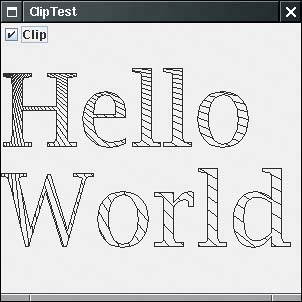Clipping
|
| By setting a clipping shape in the graphics context, you constrain all drawing operations to the interior of that clipping shape. g2.setClip(clipShape); // but see below g2.draw(shape); // draws only the part that falls inside the clipping shape However, in practice, you don't want to call the setClip operation, since it replaces any existing clipping shape that the graphics context may have. For example, as you will see later in this chapter, a graphics context for printing comes with a clip rectangle that ensures that you don't draw on the margins. Instead, call the clip method. g2.clip(clipShape); // better The clip method intersects the existing clipping shape with the new one that you supply. If you just want to apply a clipping area temporarily, then you should first get the old clip, then add your new clip, and finally restore the old clip when you are done:
In Example 7-6, we show off the clipping capability with a rather dramatic drawing of a line pattern that is clipped by a complex shape, namely, the outline of a set of characters (see Figure 7-22). Figure 7-22. The ClipTest program
To obtain character outlines, you need a font render context. Use the getFontRenderContext method of the Graphics2D class. FontRenderContext context = g2.getFontRenderContext(); Next, using a string, a font, and the font render context, create a TextLayout object: TextLayout layout = new TextLayout("Hello", font, context); This text layout object describes the layout of a sequence of characters, as rendered by a particular font render context. The layout depends on the font render contextthe same characters will look different on a screen or a printer. More important for our current application, the getOutline method returns a Shape object that describes the shape of the outline of the characters in the text layout. The outline shape starts at the origin (0, 0), which is not suitable for most drawing operations. Therefore, you need to supply an affine transform to the getOutline operation that specifies where you would like the outline to appear. We simply supply a translation that moves the base point to the point (0, 100). AffineTransform transform = AffineTransform.getTranslateInstance(0, 100); Shape outline = layout.getOutline(transform); Then, we append the outline to the clipping shape. GeneralPath clipShape = new GeneralPath(); clipShape.append(outline, false); Finally, we set the clipping shape and draw a set of lines. The lines appear only inside the character boundaries. g2.setClip(clipShape); Point2D p = new Point2D.Double(0, 0); for (int i = 0; i < NLINES; i++) { double x = . . .; double y = . . .; Point2D q = new Point2D.Double(x, y); g2.draw(new Line2D.Double(p, q)); // lines are clipped } Here is the complete program. Example 7-6. ClipTest.java 1. import java.awt.*; 2. import java.awt.event.*; 3. import java.awt.font.*; 4. import java.awt.geom.*; 5. import java.util.*; 6. import javax.swing.*; 7. 8. /** 9. This program demonstrates the use of a clip shape. 10. */ 11. public class ClipTest 12. { 13. public static void main(String[] args) 14. { 15. JFrame frame = new ClipTestFrame(); 16. frame.setDefaultCloseOperation(JFrame.EXIT_ON_CLOSE); 17. frame.setVisible(true); 18. } 19. } 20. 21. /** 22. This frame contains a checkbox to turn a clip off 23. and on, and a panel to draw a set of lines with or without 24. clipping. 25. */ 26. class ClipTestFrame extends JFrame 27. { 28. public ClipTestFrame() 29. { 30. setTitle("ClipTest"); 31. setSize(DEFAULT_WIDTH, DEFAULT_HEIGHT); 32. 33. final JCheckBox checkBox = new JCheckBox("Clip"); 34. checkBox.addActionListener(new 35. ActionListener() 36. { 37. public void actionPerformed(ActionEvent event) 38. { 39. panel.repaint(); 40. } 41. }); 42. add(checkBox, BorderLayout.NORTH); 43. 44. panel = new 45. JPanel() 46. { 47. public void paintComponent(Graphics g) 48. { 49. super.paintComponent(g); 50. Graphics2D g2 = (Graphics2D)g; 51. 52. if (clipShape == null) clipShape = makeClipShape(g2); 53. 54. g2.draw(clipShape); 55. 56. if (checkBox.isSelected()) g2.clip(clipShape); 57. 58. // draw line pattern 59. final int NLINES = 50; 60. Point2D p = new Point2D.Double(0, 0); 61. for (int i = 0; i < NLINES; i++) 62. { 63. double x = (2 * getWidth() * i) / NLINES; 64. double y = (2 * getHeight() * (NLINES - 1 - i)) / NLINES; 65. Point2D q = new Point2D.Double(x, y); 66. g2.draw(new Line2D.Double(p, q)); 67. } 68. } 69. }; 70. add(panel, BorderLayout.CENTER); 71. } 72. 73. /** 74. Makes the clip shape. 75. @param g2 the graphics context 76. @return the clip shape 77. */ 78. Shape makeClipShape(Graphics2D g2) 79. { 80. FontRenderContext context = g2.getFontRenderContext(); 81. Font f = new Font("Serif", Font.PLAIN, 100); 82. GeneralPath clipShape = new GeneralPath(); 83. 84. TextLayout layout = new TextLayout("Hello", f, context); 85. AffineTransform transform = AffineTransform.getTranslateInstance(0, 100); 86. Shape outline = layout.getOutline(transform); 87. clipShape.append(outline, false); 88. 89. layout = new TextLayout("World", f, context); 90. transform = AffineTransform.getTranslateInstance(0, 200); 91. outline = layout.getOutline(transform); 92. clipShape.append(outline, false); 93. return clipShape; 94. } 95. 96. private JPanel panel; 97. private Shape clipShape; 98. private static final int DEFAULT_WIDTH = 300; 99. private static final int DEFAULT_HEIGHT = 300; 100. } java.awt.Graphics 1.0
java.awt.Graphics2D 1.2
java.awt.font.TextLayout 1.2
|
|
EAN: 2147483647
Pages: 156
